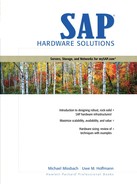Applications Compete for Bandwidth!
As mentioned previously, the network bandwidth consumption for a typical SAP user is very low. This is because of SAP R/3's architecture and the efficient manner in which it supports communication between the PC on the end user's desk and the application servers. Therefore, even the lowest bandwidth provided by modern LAN technologies will be more than sufficient for a relatively high number of SAP users.
However, in the real world, there are no networks running just mySAP.com traffic. Today's LANs are integrated information superhighways that transport a multitude of data streams. In the near future, networks also will be used for audio traffic via Voice-over-IP technology, as well as with multimedia data streams for video-on-demand applications. SAP is just one of many applications contending for network resources. This network traffic can be divided into three main categories: mission critical, time critical, and the rest. Prior to deploying any mission-critical application, it is essential to understand completely the various traffic types traversing the network, as well as their relative importance, bandwidth requirements, and tolerance for latency.
The average bandwidth demand of some typical client applications include:
| • SAPGUI | 1.5–30 Kbps |
| • Voice over IP | 12 Kbps (compressed) |
| • MPEG Video | 1.45 Mbps |
| • Mail, File Transfer | many MB but not time critical |
When we compare the bandwidth consumption of today's (and tomorrow's) typical online client activities, we find again that SAP R/3 is generating the lowest network traffic of all. However, even the worst case, MPEG-coded video-on-demand, does not exceed standard Ethernet speeds of 10 Mbps to the desktop.
However, where the data streams accumulate on a shared network media, the mySAP.com traffic competes with other applications, regardless of the mission-critical nature of SAP traffic. There is no easy way to prioritize the data traffic of specific applications in a network segment based on shared media. Implementing higher bandwidths on a shared media network does not solve the problem—it is just accelerated.
With mass proliferation of inexpensive LAN switching technology, dedicated connections can be provided on a per user basis. There is no shared media in such a so-called full switched network. All bandwidth between cabling cabinet and end-user desktop is dedicated to this user. The migration from shared to switched networks demands replacement of all hubs within the network by switches, mandatory for deployment of traffic prioritization. Deploying full switched networks is a straightforward solution to the application competition for bandwidth problem. To ensure reasonable SAP response times in a local area network, the migration from a shared to a switched network infrastructure is recommended.
